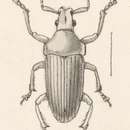Description
provided by INOTAXA archive
♂. Oblong, black, densely clothed above and beneath with whitish scales, the head, under surface, and legs also more or less pilose, the antennal club blackish. Rostrum widened towards the base, broadly excavate anteriorly; eyes rounded, very prominent; antennal scape reaching the front of the prothorax, stout, rapidly widening outwards, joints 1—3 of the funiculus subequal in length, the other joints shorter. Prothorax abruptly, quadrangularly explanate on each side from about the middle to the base, and here much wider than the elytra and nearly twice as broad as long, the base moderately bisinuate. Scutellum transverse. Elytra moderately long, gradually narrowing from the base, very finely punctate-striate, the seriate punctures on the disc scarcely coarser than those of the flattened interstices. First ventral segment hollowed down the middle, the fifth slightly tumid along the median line posteriorly.
Length 8, breadth of prothorax 3, of elytra 2 4/5 millim.
Champion in: David Sharp & G. C. Champion, Oct. 1911. Biol. Centr.-Amer.,Coleoptera, vol. 4, pt. 3: 246.
- license
- cc-by-3.0
- copyright
- Biologia Centrali-Americana
Distribution
provided by INOTAXA archive
Hab.MEXICO, Rio Balsas, near Cuernavaca (H. F. Wickham).
- license
- cc-by-3.0
- copyright
- Biologia Centrali-Americana
Physical description
provided by INOTAXA archive
One specimen only of this remarkable species has been sent us by Mr. Wickham. It was found in the summer of 1909. The broadly quadrangularly explanate prothorax separates it at once from all the allied forms. It is possible that the female may differ in this respect.
- license
- cc-by-3.0
- copyright
- Biologia Centrali-Americana

